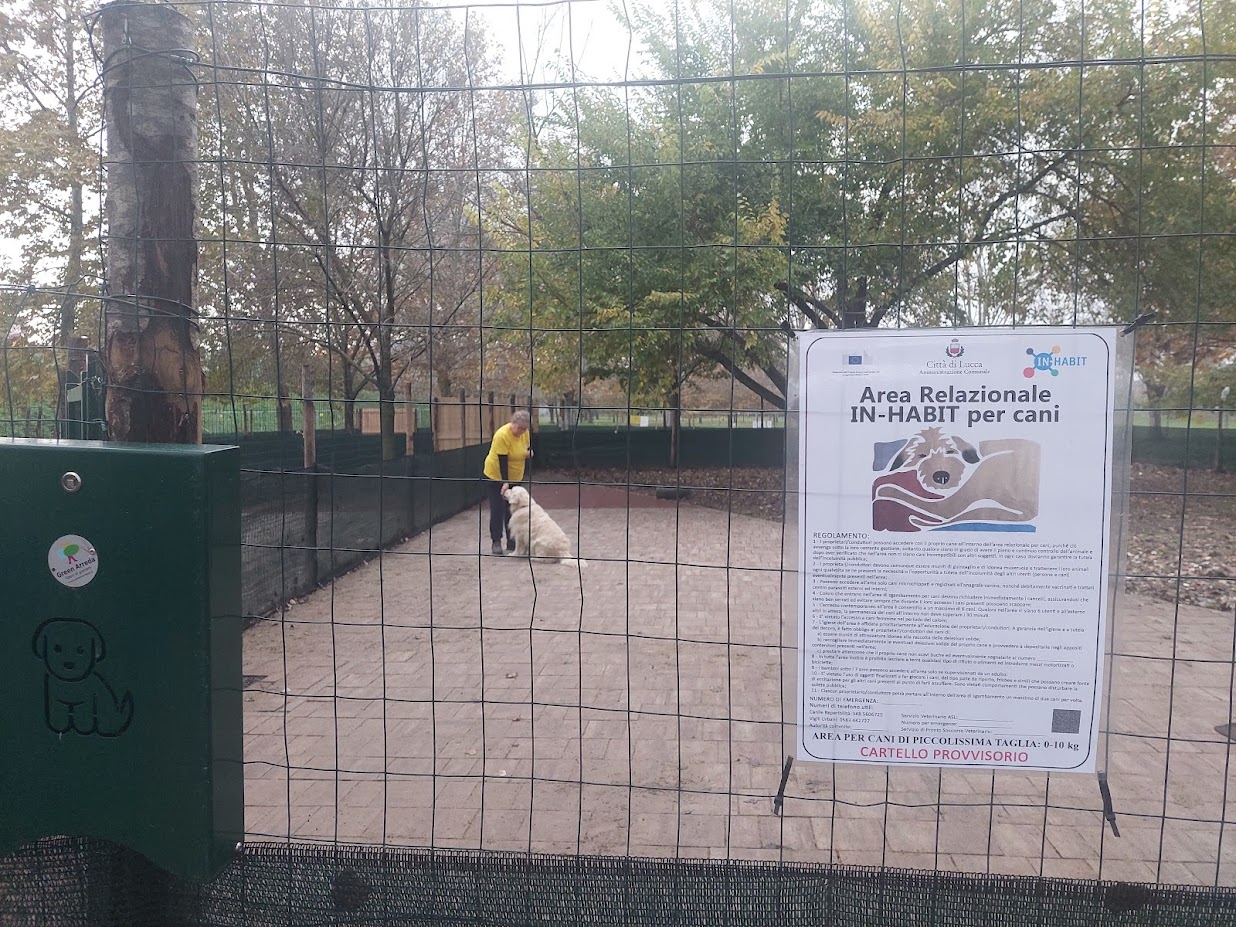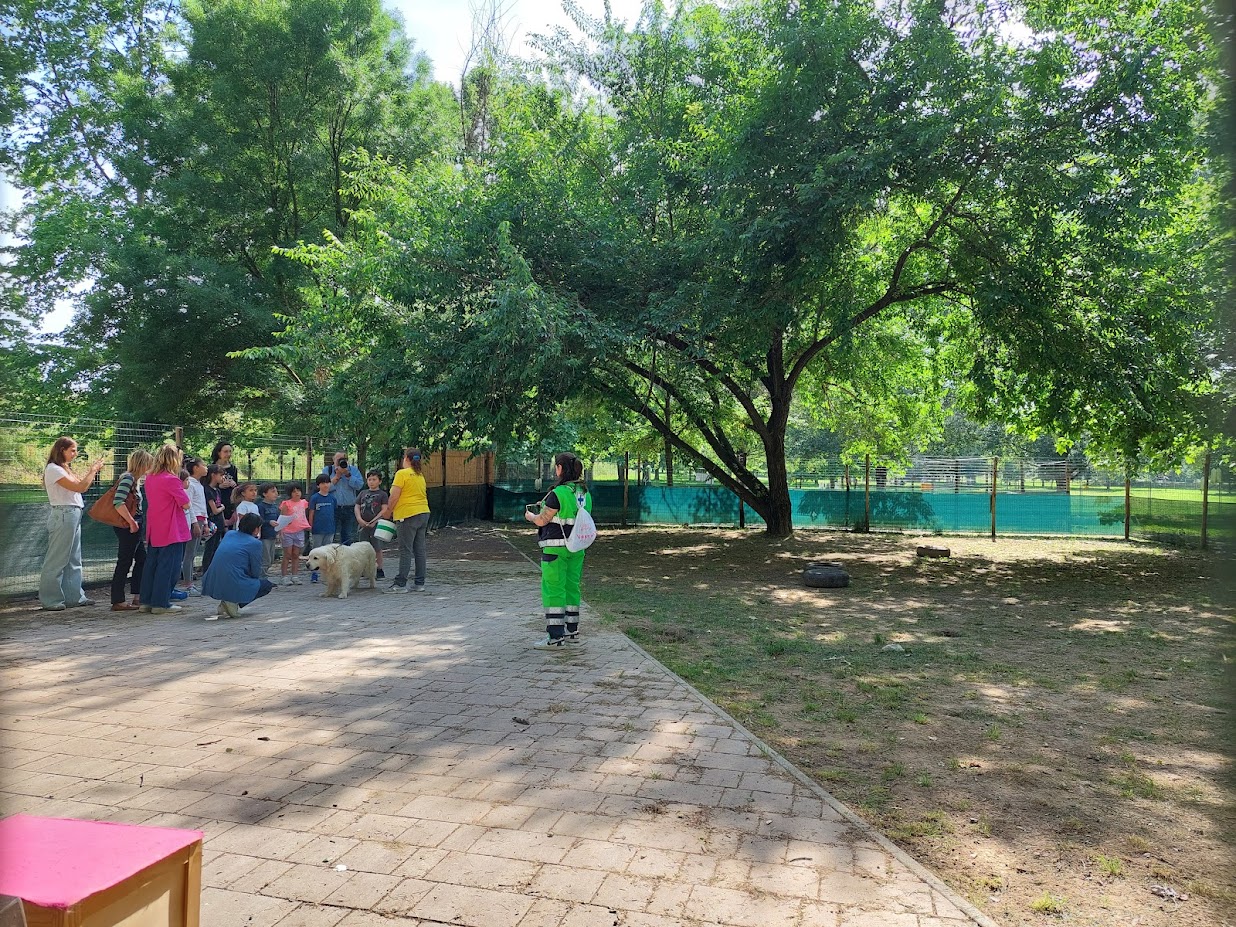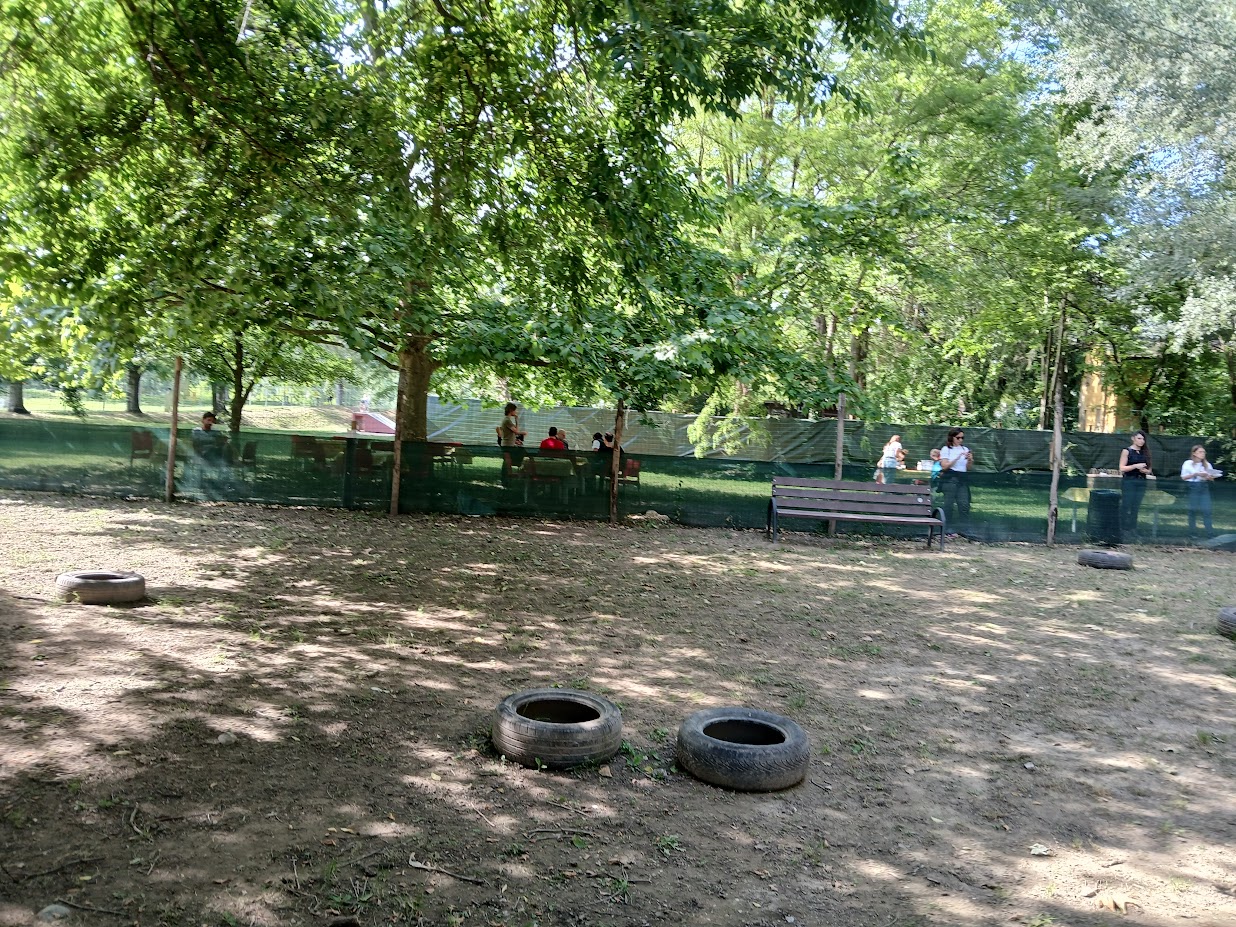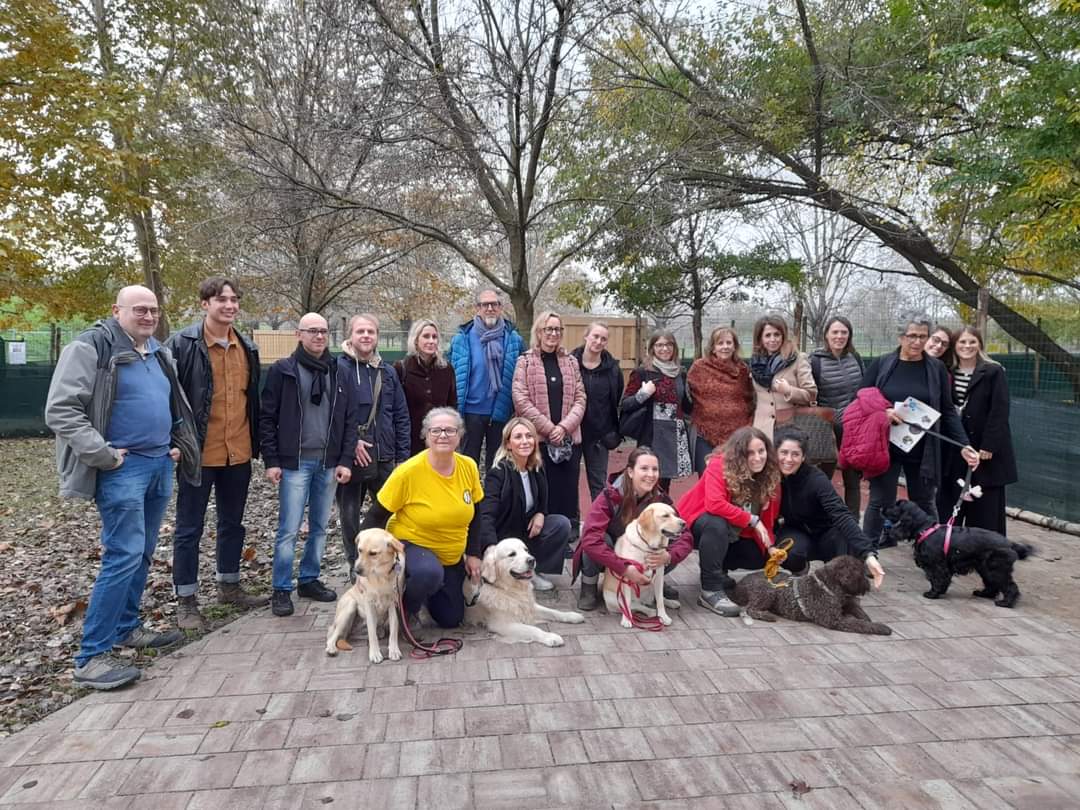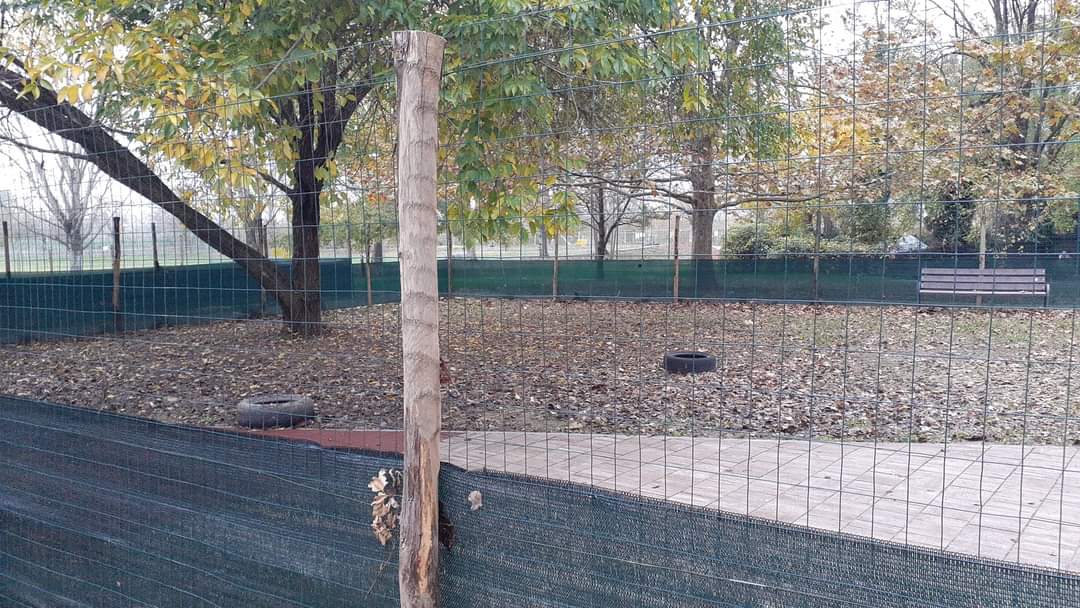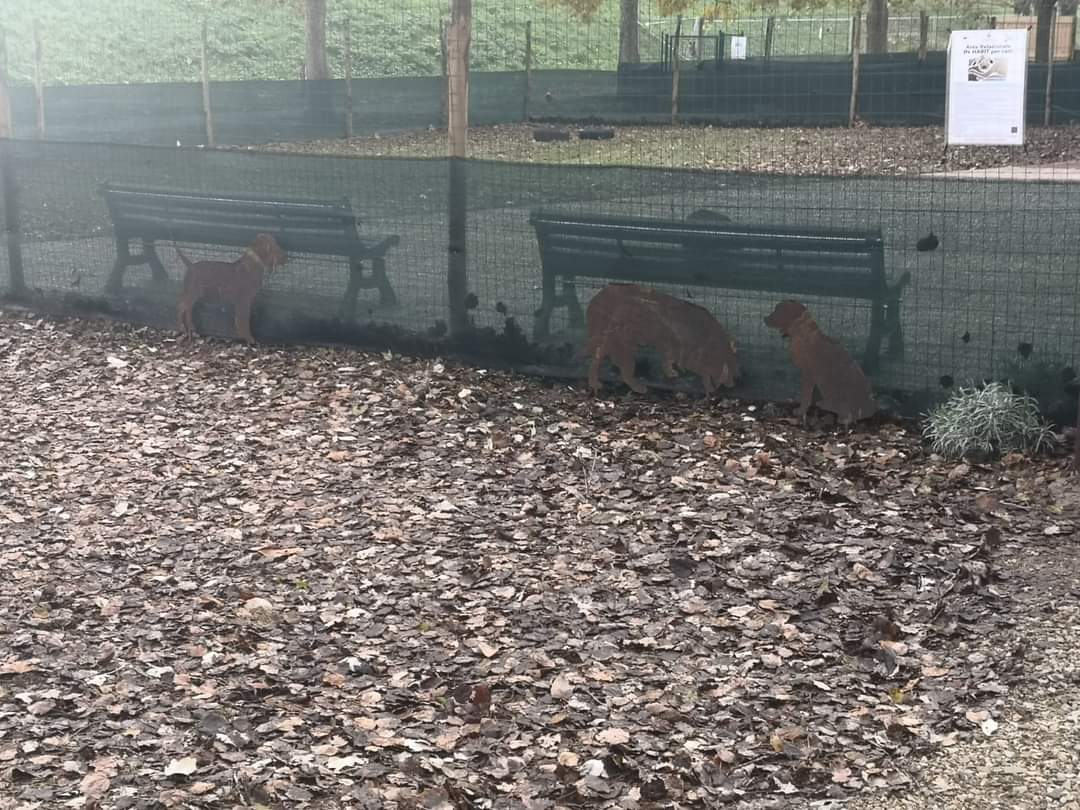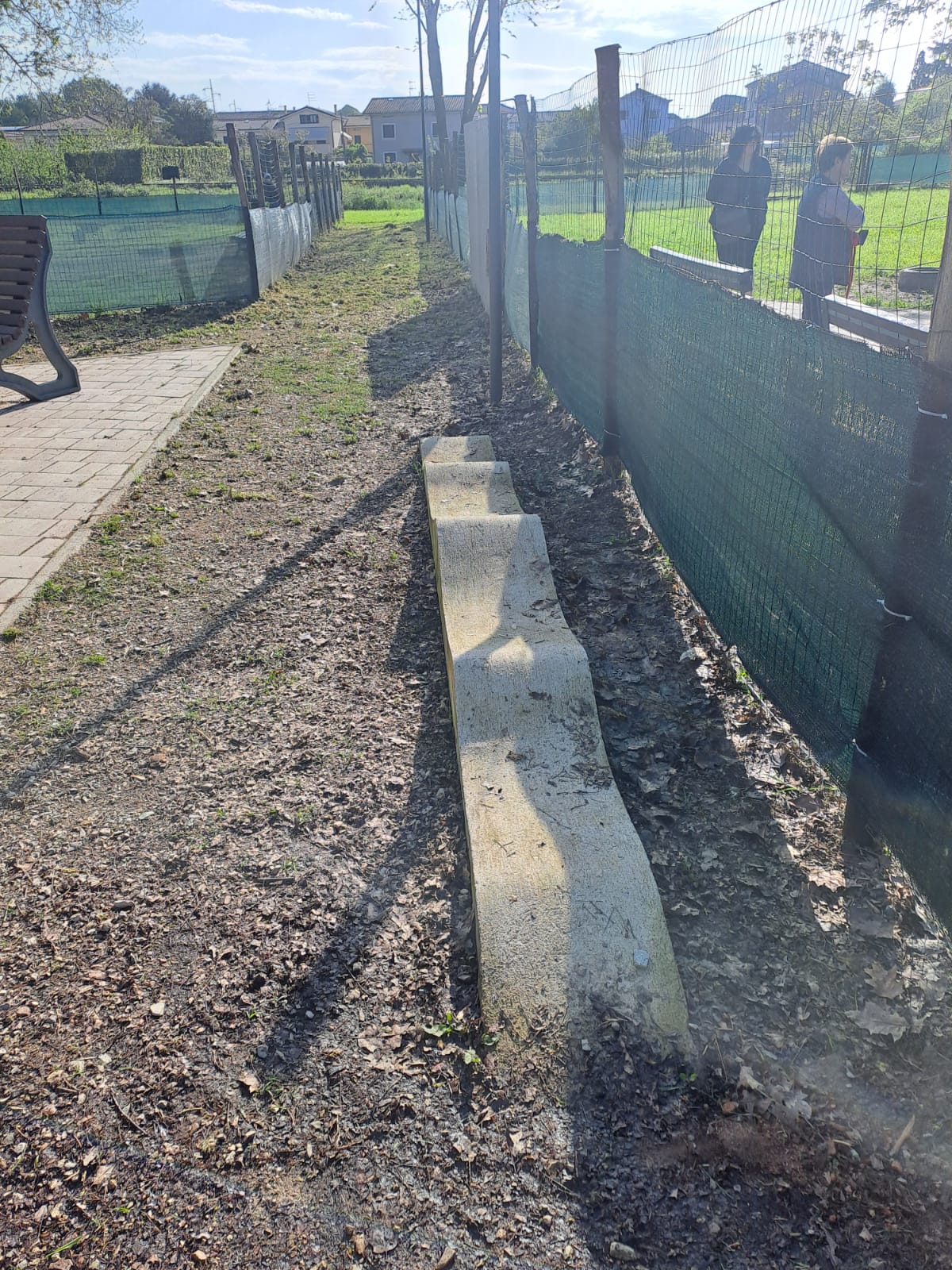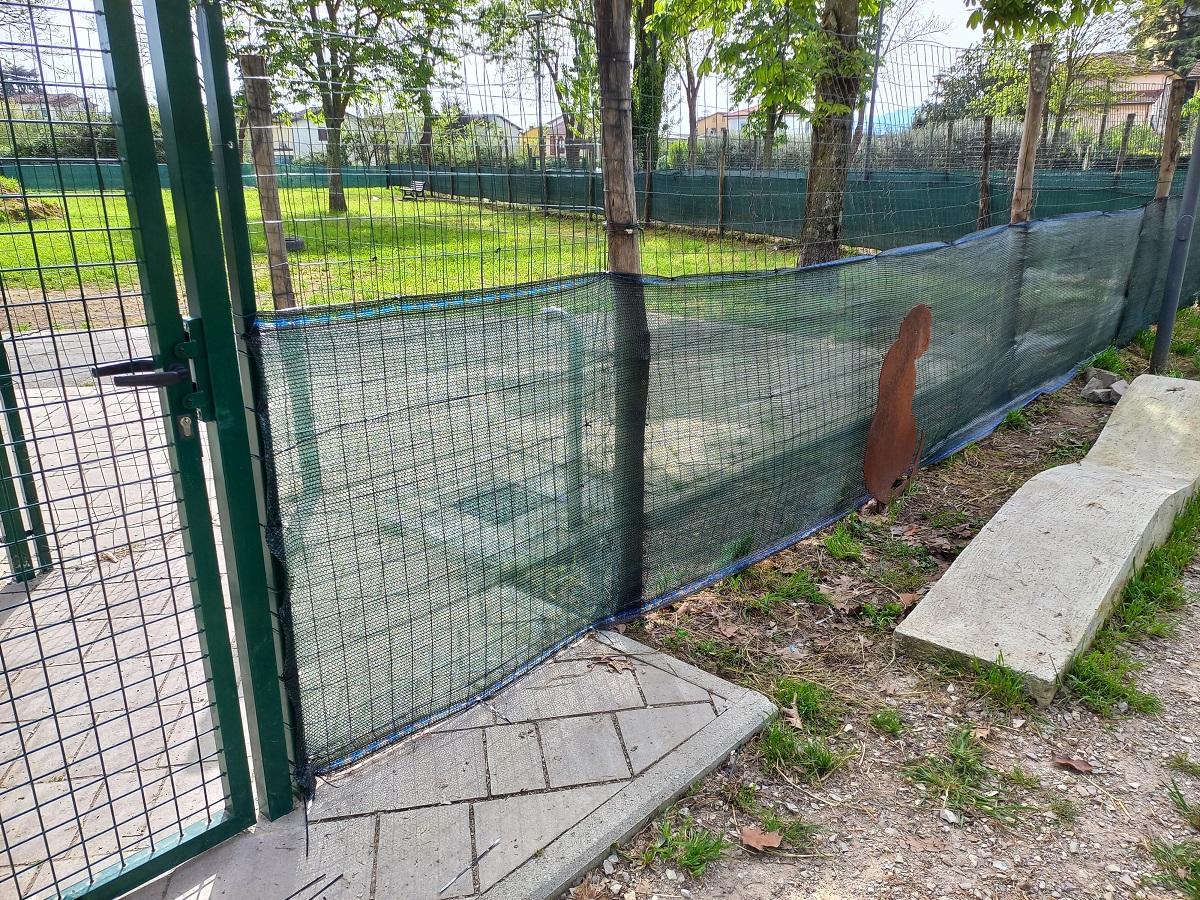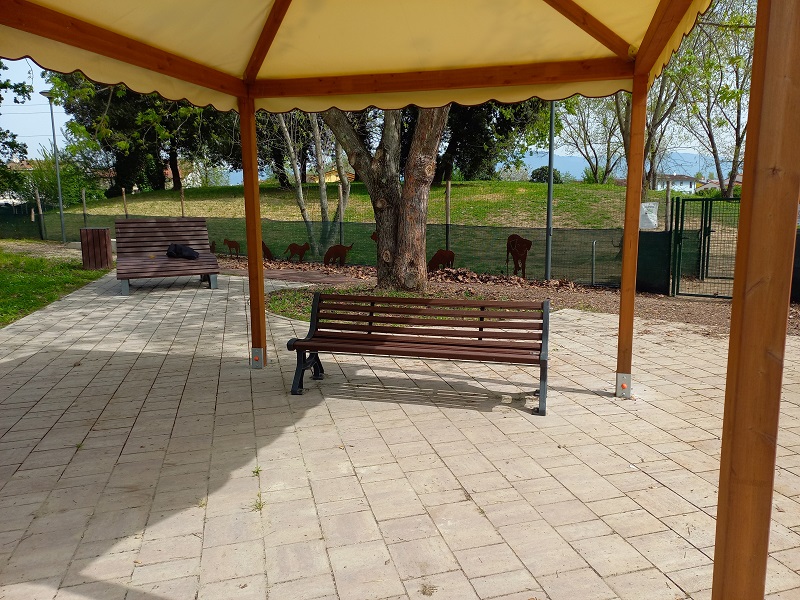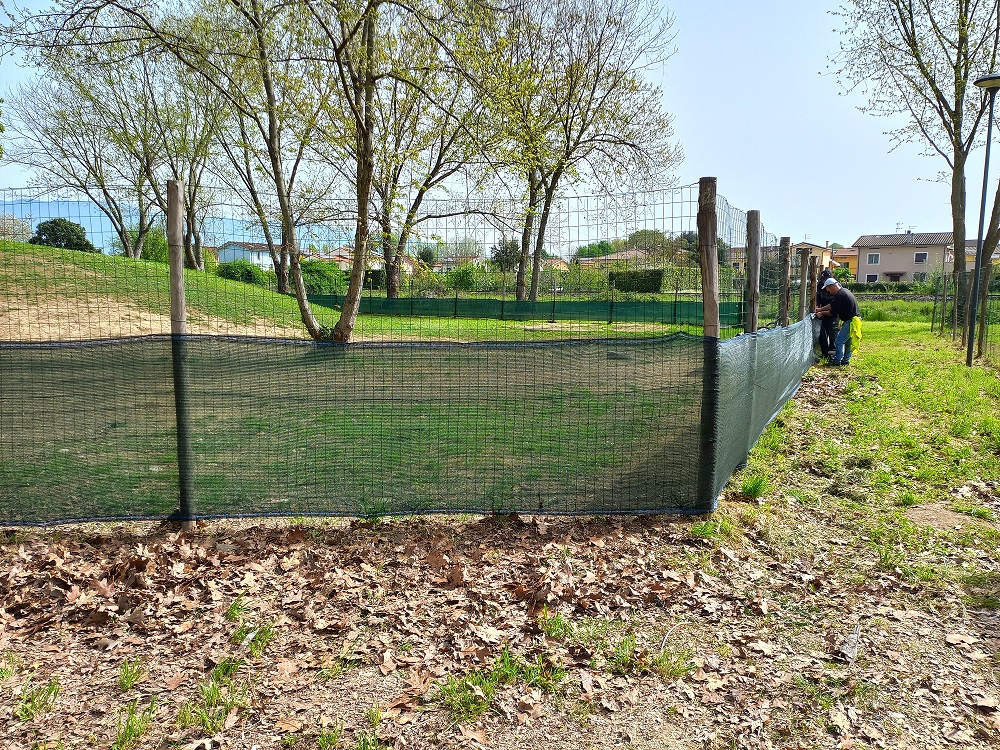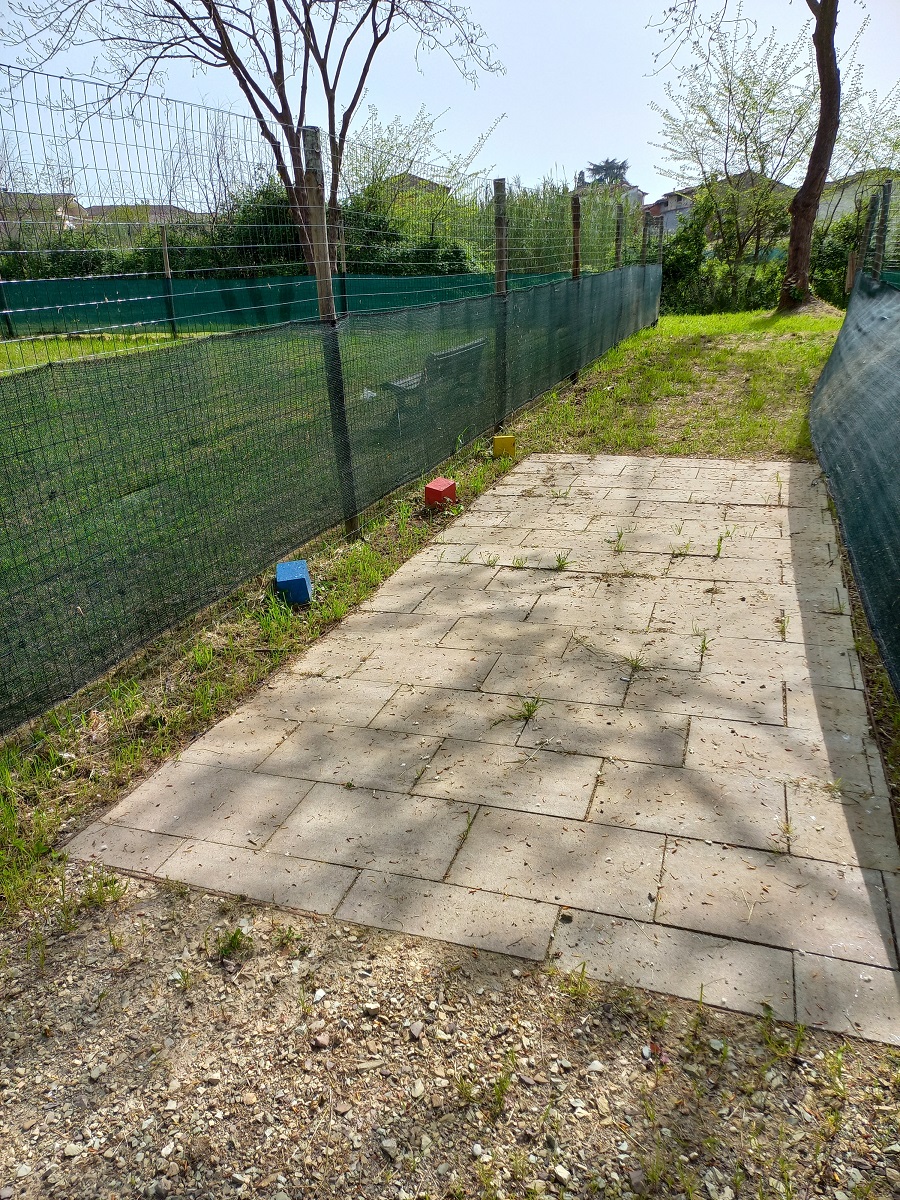Reconnecting with nature
NBS in Lucca: The Hum-animal Areas
Animal-nature based solutions in Lucca: The Hum-animal Areas
The 2 Hum-animal Relational Areas are part of the 15km Animal lines, much more than simple dog run areas, rather green places conceived and designed with the aim of making the moments of sharing a source of psychophysical wellbeing for humans and pets, inreasing neighborly and dialogue. With their special vibe and NBS furnitures, the Relational Areas are an inclusive, accessible meeting space, enjoyable in all its parts to host events and activities involving the whole community
Italy
National
Mainly urban
It refers to a physical transformation of the built environment (hard investment)
Yes
2023-11-30
Yes
Horizon2020 / Horizon Europe
No
No
As a representative of an organisation
The ever increasing presence of pets in the town of Lucca seems to create a new possibility of re-establishing authentic contacts between people and nature through the affection for animals.From this common feeling was conceived the prospect of expanding the offer of spaces suitable for man-animal relationship by moving to the surrounding suburbs by reorganising and regenerating part of the existing urban space through NBS, to create a new infrastructural green urban system strictly connected with the city centre.This bind was sealed with the creation of a virtual route, “The Animal Lines” that winds through the municipal territory and identifies a series of itinerary that leads to the two "Hum-animal Relational Areas". Set in abandoned and desused areas near the former hospital Campo di Marte and inside the Serchio River Park,the Relational Areas are fenced green spaces for free outdoor physical activity, equipped with furniture designed to be in perfect harmony with the surrounding environment and to accommodate not only the owner, but also the pet, sensory paths to stimulate the sense of smell and playground games made with eco-friendly materials; much more than simple dog run areas, but rather quiet, shaded and safe places conceived and designed with the aim and intent of making the most of moments of sharing and entertainment enjoyble for everyone. As a matter of fact, the initial inspiration behind the construction of these two places and the quality of the project have produced an unexpected powerfull evolution. From the very beginning, the two areas were deeply appreciated even from people who do not own pets. The citizen endeed, decreed these spaces as two of their favorite sites in Lucca as we can perceive from the extensive daily attendance, with great pleasure for the Administration which is bringing multiple trasversal activities to these places involving all sectors of the local body(culture,social,schools,shelter for the elders)and new stakeholders
nature based solutions
regeneration
innovation
co-deployment
inclusion
Sensibility towards nature was the ispirational trend for the development and creation of the two relational areas, -fulcrum of the “Animal Lines”, the virtual route that reconnects city places in a path tailored to valorized human-animal-, who had involved landscape architects, ethologists and academics in a study aimed at creating an “eco-friendly project” with the use of NBS to generate the best conditions, respecting the alleys sanctioned by law and, at the same time, respecting biodiversity and the environment. With this aim, the Administration has previously selected quiet and easily accessible abandoned green spaces in fairly isolated areas,(near car parks or activities that can benefit from them), located in the suburbs and in the River Park characterized by the presence of a specific fauna and flora. Then, an “Environmental feasibility study” was carried out with the score of verifying the compatibility of the proposed intervention with the provisions of the urban planning tools in compliance with the existing restrictions and the foreseeable effects on the environment and on the health of citizens. The interventions consisted in the setting of fences and the costruction of walkways and have been designed to have as little impact as possible on the environment becoming one with it, employing natural, low impact and recicled materials such as wooden posts and mesh netting loose for fences and furnishing, draining and naturalistic material for the walkways which blend harmoniously with the natural context. Moreover, in the River Park area, a biodiversity listening and monitoring system with its acoustic sensors, captures a wide range of sounds/ultrasounds emitted by local fauna(bats, grasshoppers, birds, butterflies and fireflies),allowing a data acquisition campaign, to monitor and study the state of "ecosystem health" of that portion of the local territory, with the support of EU scientific partners
With the creation of the “The Hum-animal relational areas” , the Municipality has handed over to the town two retrained, beautiful and safe places which have become, to the whole community, from the most frequented sites and socialization points, not only for pets owners, but for everyone who wants to enjoy a bit of calm surrounded by nature.The total absence of architectural barriers allowed the full access to the all surface of the areas even to disabled people who can enjoy the quiet and shaded atmoshpere of these places, breathing clean air and perfumed scents. Along the external net that surrounds the entire dog running area, rosemary plants with their aromas are not only performing the function of keeping insects away from people in summer time, but create fragrant sensory emotions that enrich the experience of those who attend these places with their pet or just to take a rest reading a book. On site there are also “ the colored cubes” in which it‘s possible to hide tea or herbal tea bags to stimulate the use of the canine sense of smell and through it encourage to play together, allowing both species to discover and experience another moment of shared well-being. Moreover, in the shaded area in front of the Ex Campo di Marte Relational Area there is the "Hum-animal bench" with its large seat designed with the aim of allowing easy ascent and descent by supporting the dog's movement and reducing joint strain with benefits for the musculoskeletal structure, and then making it rest alongside his human companion. As demonstrated by scientific research lead by Dipartimento di Scienze veterinarie di UNIPI who gave his scientific contribution to the technical project, physical contact between humans and pets, can lead to an increase in the production of oxytocin, a hormone associated with the formation of social bonds and the reduction of stress in both species.The bond between human and his dog is completely similar to that existing between mother and child.
Conceived and designed with the aim of creating accessible places, free from architectural barriers, the “Hum-animal relational areas” catalyze the presence of the entire local community, therefore a wider audience than the initial target,who spend time there to entertain pets, to enjoy moments of rest and take part to the several cultural and social initiatives. Endeed, the regular users of these areas are families, caregivers, students from schools of every degree, local shelters for elders, educators and Associations some of which are involved in the maintenance of the decorum of the areas and that, in their voluntary activity have identified these places to bring people they have in charge. In a surprising evolution that moves from the original idea of creating places suitable to allow the best valorisation of the hum-animal bond, areas are attended by citizens of all ages and different social backgrounds, providing a constant source of social interaction and exchange which also involves the most fragile categories, such as disable people and the elder: the Administration is thinking to replicate some project activities hosting them in these openair locations, i.e the great recent experience of the pet therapy experience. Children are also welcome in these places and for them the Municipality, with the help of the educators of the “Municipal Library Agorà” is organizing reading cycles themed on the relationship between humans and animal, small workshops. Children of the primary schools are habitual visitors to the areas, where cultural events are periodically planned in spring time at the end of the educational program lead by Dipartimento di Scienze Veterinarie and partner Lucca Crea related to the Horizon2020 IN HABIT project, with whose resources financed the works necessary for the construction of the 2 areas. These areas are also a great catalyst for the teenagers who attend the schools located in those neighborhood, offering them a safe meeting place
Since the very beginning of the creation process of the two “Hum-animal Relational areas”, the entire community of Lucca has been involved in the co-planning through the sessions of “Participatory Processes” activated by the Municipality of Lucca, in which the community has had the opportunity to freely express its will on the matter and in particular, expressing a choice on the locations identified for the construction and on the other subsequent possible actions related to them. The initial co-design phase of the areas was lead by Lucca and the Accademics of the University of Pisa working with 5 groups of people identified between the Citizen for their specific characteristics and needs as belonging to the Tourism sector, the Social sector, Pet care professional sector, Education, families and associations. These people worked in plenary and in separate groups to share the topic. In the beginning, due to the Pandemic situation, activities were organised online, then physical meetings have become increasingly frequent and productive allowing mutual knowledge and easier exchange. The importance of participation and the quality of the contribution of ideas and solutions have led to the creation of the IN HUB as a stable partecipation tool in which individuals belonging to the citizens of Lucca who meet periodically with the Municipality to express themselves and their needs, finding in this virtual but also physical meeting place, all the necessary informations on the initiatives that concern the two relational areas and give imputs on further implemention. Lucca community through frequenting, animating and respecting the relational areas, aligning themselves with the provisions contained in the "Norme di condotta", contribute to their vitality.
The future activities on the areas will be planned continuing the co-planning and co-designe process with the involvement of the In Hub, assuring the sustainability of the project.
The future activities on the areas will be planned continuing the co-planning and co-designe process with the involvement of the In Hub, assuring the sustainability of the project.
The IN HUB is composed by people who belong for their own characteristics to different categories of interest between the community of Lucca. This peculiarity has been, together with the Horizon2020 GA869227 IN HABITproject, a powerful communication and engagement tool which has stimulated the interest and curiosity of ever new stakeholders who have, in several occasions and many different ways, contributed to the realization of the project of the two areas and to their animation with innovative activities. This has happened in the contest of the local voluntary associations as one of them, in particular, after hearing about the “pet friendly project” from some of the Inhub participants, has offered its contribution to the monitoring of the areas by collaborating with the Administration on correct maintenance and timely reporting problems and dangers for the citizens. And again local associationism that deal with the protection of animal rights, shows its constant interest and presence in the areas and give a strong support in the initiatives by offering demonstrations of pet therapy, interventions to children and elders, assistance and support for the animals care of people belonging to vulnerable categories, in this way also fulfilling its social function. Even the local education enthities have also shown their interest in several occasions, confirming that the respect for nature and the human-animal bond is a source of growth and psychophysical well-being for children and their awarness, to host educational activities, workshops, small outdoor shows. Finally, due to of the position of the two areas, in particular the one near the old Campo di Marte hospital, the nearby commercial activities could benefit as a result of the close and widespread attendance of the areas.
Recently also Tuscany Region has expressed its interest to collaborate in spreading the aim of the project and to foster its replicability in the Region, also with its EU rapresentatives offices
Recently also Tuscany Region has expressed its interest to collaborate in spreading the aim of the project and to foster its replicability in the Region, also with its EU rapresentatives offices
The technical project developed for the creation of the hum-animal relational areas takes its steps from a previous in-depth scientific study with a strong environmental and ethological connotation lead by the Accademics and PHD of the Department of Veterinary Sciences of the University of Pisa, which identified in the landscape of the town of Lucca,a medium-sized city in Tuscany, the optimal characteristics to be able to concretely put to the ground an innovative idea, by creating urban places in which citizens could benefit psychophysically through the relationship with the pet. These skills, together with the needs and hopes expressed by the citizens during the co-design process, have been incorporated into the text of a technical project that expresses a deep sensitivity towards the environment, as demonstrated by its “Environmental feasibility study” part, and towards animals which have allowed the creation of spaces to offer not only moments of simple physical exercise, but of real emotional sharing from which proven well-being derives.
We can identify a strong contribution by the scientific field, in particular the yet named UNIPI Veterinary Sciences Department, to enforce the high technical level of the design process.
Another fundamental contributors have been the architectural support from the In HUB context, starting fron the different targing groups involved: some architects gave their project support, such as some representatives of the health field, both as veterinarians and as mental health workers, or operators for assisted therapies for fragile and target subjects for the use of animal lines.
The resume of all these contributions were reported in a specific deliverable of the project, confirming the scientific approach to the design and implementation of the project
We can identify a strong contribution by the scientific field, in particular the yet named UNIPI Veterinary Sciences Department, to enforce the high technical level of the design process.
Another fundamental contributors have been the architectural support from the In HUB context, starting fron the different targing groups involved: some architects gave their project support, such as some representatives of the health field, both as veterinarians and as mental health workers, or operators for assisted therapies for fragile and target subjects for the use of animal lines.
The resume of all these contributions were reported in a specific deliverable of the project, confirming the scientific approach to the design and implementation of the project
The innovative nature of the project "The Hum-animal Relational areas" is appreciable from two distinct profiles: one related to the effective innovative work carried out in the urban context and one related to the experimentation of new administrative procedures, which have been used by the Municipality to identify the subjects involved in the “soft solutions” co planning (co-progettazione with third sector bodies for a “pet care service” for elder and disabled people still active and ongoing) implemented starting from the Horizon 2020 IN-HABIT project and continuing with the development of the current project with wich the Municipality would consolidate the satisfactory results already obtained and to be extended and replicated in the future.
"The Hum-animal Relational areas" with their special warm atmosphere and their goal to allow the best human-animal interaction to enjoy in these places all the mutual benefits for the physical and mental health, are a novelty in the territory of the town of Lucca, which already have only two conventional “dogs run areas”, with strict behavioral rules even in terms of time of attendance inside the areas, but also in the italian context.
The Hum-animal Relational areas concept are much more than simple dog run areas: are innovative urban green pleasant places immerged in nature, opened all day long and equipped with innovative urban furniture and lighting during the night, conceived and designed with the aim of making the moments of sharing an unforgettable experience, for everyone who attended these spaces.
These areas are attended by all the citizens, even those who do not own a pet and local associations and schools to whom the administration has already opened up the possibility of free use of the places for the organization of events, outdoor workshops and anything else that may be organized there. Furthermore, the scientific research approach provides scientific data on the degree of innovation of the project.
"The Hum-animal Relational areas" with their special warm atmosphere and their goal to allow the best human-animal interaction to enjoy in these places all the mutual benefits for the physical and mental health, are a novelty in the territory of the town of Lucca, which already have only two conventional “dogs run areas”, with strict behavioral rules even in terms of time of attendance inside the areas, but also in the italian context.
The Hum-animal Relational areas concept are much more than simple dog run areas: are innovative urban green pleasant places immerged in nature, opened all day long and equipped with innovative urban furniture and lighting during the night, conceived and designed with the aim of making the moments of sharing an unforgettable experience, for everyone who attended these spaces.
These areas are attended by all the citizens, even those who do not own a pet and local associations and schools to whom the administration has already opened up the possibility of free use of the places for the organization of events, outdoor workshops and anything else that may be organized there. Furthermore, the scientific research approach provides scientific data on the degree of innovation of the project.
The two Hum-animal relational areas were designed following the methodology exploited in the research project Horizon2020 In Habit by the Dipartment of Veterinary science of the University of Pisa based on 5 indicators:
Subjective Well-being: This dimension considers personal perceptions of psychological well-being, happiness and life satisfaction.
Spatial and Environmental Well-being: This includes the quality of physical surroundings, green spaces, and environmental health.
Social Well-being: This addresses social cohesion, community engagement, and social support networks.
Healthy Lifestyles: This dimension focuses on behaviours such as physical activity, diet, and substance use.
Economic Well-being: This encompasses income levels, employment status, and economic security.
This methodology find its main realization in the partecipatory processes implemented in Lucca.The methodology lies in the recognition of health and well-being as co-created common pool resources influenced by the collectivity and the environment in which individuals reside and not exclusively linked to the individuals. Consequently, the assessment of health and well-being must be adaptable to the distinct characteristics of different urban settings. This hypothesis is particularly important considering small and medium-sized cities like Lucca, which often face unique challenges and circumstances that larger metropolitan frameworks may not properly address. The project is in line with the current EU policy priorities: the EU Green Deal making Europe a climate-smart continent; the One Health approach and its links to human and nature health; the Nature Based Solution approach and the need for green-blue, but also animal spaces; the Biodiversity-Climate nexus; the restoration of urban ecosystems, aligned with the Nature Restoration Law, and last but not least, the New European Bauhaus. The project give evidence to make these policies operational for the most vulnerable groups and places.
Subjective Well-being: This dimension considers personal perceptions of psychological well-being, happiness and life satisfaction.
Spatial and Environmental Well-being: This includes the quality of physical surroundings, green spaces, and environmental health.
Social Well-being: This addresses social cohesion, community engagement, and social support networks.
Healthy Lifestyles: This dimension focuses on behaviours such as physical activity, diet, and substance use.
Economic Well-being: This encompasses income levels, employment status, and economic security.
This methodology find its main realization in the partecipatory processes implemented in Lucca.The methodology lies in the recognition of health and well-being as co-created common pool resources influenced by the collectivity and the environment in which individuals reside and not exclusively linked to the individuals. Consequently, the assessment of health and well-being must be adaptable to the distinct characteristics of different urban settings. This hypothesis is particularly important considering small and medium-sized cities like Lucca, which often face unique challenges and circumstances that larger metropolitan frameworks may not properly address. The project is in line with the current EU policy priorities: the EU Green Deal making Europe a climate-smart continent; the One Health approach and its links to human and nature health; the Nature Based Solution approach and the need for green-blue, but also animal spaces; the Biodiversity-Climate nexus; the restoration of urban ecosystems, aligned with the Nature Restoration Law, and last but not least, the New European Bauhaus. The project give evidence to make these policies operational for the most vulnerable groups and places.
Lucca’s project fill a gap in the NBS reflection looking to the potential of the animal presence/promotion in the cities. Animals can support green transition building enjoyable, attractive and convenient places for all as the case of the relational areas and the humanimal strategy in Lucca shows. Living spaces able to improve well-being, social dialogue and community welfare can be enriched by taking into consideration human-animal bonds, cities’ infrastructures, and services. INHABIT project has designed tools and guidance to make transferable the Lucca experiment and its solutions abroad. Contacts already started with cities in Italy (Rome, Milan, Pesaro, Massa), Tuscany Region, Bogotà and Medellin in Columbia. Dialogue with policymakers brought the hum-animal city plan idea in an Italian law’ proposal. The idea has a large potential for most cities where the ongoing societal/cultural change and the diffusion of animals generate demands and opportunities. Besides devoted infrastructures, there is a high potential in terms of economic, social and cultural engagement at grassroot level and the social inclusion of fragile people. Pet-economy is growing on a world scale with enlarging job opportunities, also for young people and fragile workers.The high potential for transferability is also due to the idea’ scalability. As the dialogue with other cities teach, any city has resources, green spaces, demands that can be combined starting from small/specific solutions to broader/complex ones. Key points in transferability/replicability are: clear shared goals with the municipalities, design of a well guided participatory path able to incorporate views and proposals from many stakeholder in a mindset-shift approach, co-design of tailor made solutions with emerging needs and opportunities, progressive test of pilot initiatives able to capture the concept into tangible outcomes and progressively reinforce and expand the idea at city level.
The emerging need for the use of inclusive, innovative urban public spaces that allow the livability of the urban context by citizens as actors and beneficiaries of the environment in which they live, are global challenges that are now known and affirmed worldwide, especially after the period of the Covid-19 pandemic. As a large part of the scientific panorama has had the opportunity to demonstrate, NBS can be one of the solutions that provide answers to emerging needs.
In this sense, the experience of the Municipality of Lucca with the Relational Areas is a concrete way to provide a solution to the need to combine the liveability of urban spaces with the social context, enhancing the aspects connected to psychophysical health, the human-animal bond and the preservation of the environment and the local ecosystem.
The even economical sustainability of the project and the related regenerative and redevelopment effect for initially disused and abandoned spaces with subsequent delivery to the citizenry of new useful, inclusive and safe areas, stimulate the city administration's ambition to proceed with a further replication of the experience in the town of Lucca and abroad, putting its experience at disposal to the possible replication site in Italy and in EU.
In this sense, the experience of the Municipality of Lucca with the Relational Areas is a concrete way to provide a solution to the need to combine the liveability of urban spaces with the social context, enhancing the aspects connected to psychophysical health, the human-animal bond and the preservation of the environment and the local ecosystem.
The even economical sustainability of the project and the related regenerative and redevelopment effect for initially disused and abandoned spaces with subsequent delivery to the citizenry of new useful, inclusive and safe areas, stimulate the city administration's ambition to proceed with a further replication of the experience in the town of Lucca and abroad, putting its experience at disposal to the possible replication site in Italy and in EU.
Lucca project generates direct and indirect outcomes and impacts for the local communities. In terms of urban infrastructures, it introduced totally new concepts and ideas in reshaping urban spaces in the perspective of community engagement and social inclusion.
During the participatory activities for the co-design of the areas and paths a large process of participation and societal dialogue has been facilitated enabling people voice in the community dialogue. The inhub involved elders, fragile, children families, educators, caregivers, and young people, Spaces have been designed with and for the use of any person, also with physical disabities.
The relational areas are very well frequented by different social strata (young elders, isolate individuals) that can there start a social dialogue also starting from the animal facilitation. In the areas cultural, didactical, gaming initiatives (with a specific humanimal board game) has been organized to enhance participation and societal dialogue also with fragile people.
For the most the new areas and paths increase active life, social dialogue and the availability of playable and sensory places. The new spaces area also closed to sheltered workshop for elders that were engaged in the interaction with animals according with national guidelines for animal assisted interventions.
From an economic point of view, new activities and job opportunities were facilitated by the project in the design and building of the areas, for the new services provided accordingly, with the involvement of the third sectors and association, as well as new firms run by women.
Also, in terms of public consensus in the political arena and the citizens involvement and participation, the humanimal solutions generate positive feedbacks. New research outcomes and opportunities were generated by the INHABIT project that has been selected by Pisa University as one of the 20 cases presented for the national evaluation of research quality.
During the participatory activities for the co-design of the areas and paths a large process of participation and societal dialogue has been facilitated enabling people voice in the community dialogue. The inhub involved elders, fragile, children families, educators, caregivers, and young people, Spaces have been designed with and for the use of any person, also with physical disabities.
The relational areas are very well frequented by different social strata (young elders, isolate individuals) that can there start a social dialogue also starting from the animal facilitation. In the areas cultural, didactical, gaming initiatives (with a specific humanimal board game) has been organized to enhance participation and societal dialogue also with fragile people.
For the most the new areas and paths increase active life, social dialogue and the availability of playable and sensory places. The new spaces area also closed to sheltered workshop for elders that were engaged in the interaction with animals according with national guidelines for animal assisted interventions.
From an economic point of view, new activities and job opportunities were facilitated by the project in the design and building of the areas, for the new services provided accordingly, with the involvement of the third sectors and association, as well as new firms run by women.
Also, in terms of public consensus in the political arena and the citizens involvement and participation, the humanimal solutions generate positive feedbacks. New research outcomes and opportunities were generated by the INHABIT project that has been selected by Pisa University as one of the 20 cases presented for the national evaluation of research quality.

